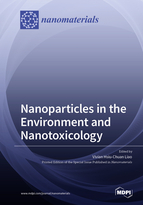Nanoparticles in the Environment and Nanotoxicology
A special issue of Nanomaterials (ISSN 2079-4991). This special issue belongs to the section "Environmental Nanoscience and Nanotechnology".
Deadline for manuscript submissions: closed (31 December 2022) | Viewed by 64177
Special Issue Editor
Special Issue Information
Dear Colleagues,
In recent decades, the applications of nanotechnology have dramatically increased in many areas such as cosmetics, medicine, food packaging, environment, agriculture, electronics, and others. Despite its useful applications, nanomaterials (at least one dimension <100 nm) due to their small size and unique properties, concerns have been raised about their potential environmental impact and hazard to human health. In addition, given the increasing production, nanomaterials might potentially release into the environment, leading to potential risks to the ecosystem. Besides engineered nanomaterials, nanoplastics, the degradation products of microplastics, have also attracted increasing concern due to the large production and usage of plastics, which might lead to widespread existence of nanoplastics in the environment and pose potential toxicity for living organisms. Until now, there are still huge gaps and unknown knowledge about the fate, behavior, and toxicity of nanoparticles in the environmental system. This Special Issue aims to gather recent novel research findings of various types of nanoparticles on the determination, detection, and degradation in the environment as well as the toxicity and risk assessment of nanoparticles.
Prof. Dr. Vivian Hsiu-Chuan Liao
Guest Editor
Manuscript Submission Information
Manuscripts should be submitted online at www.mdpi.com by registering and logging in to this website. Once you are registered, click here to go to the submission form. Manuscripts can be submitted until the deadline. All submissions that pass pre-check are peer-reviewed. Accepted papers will be published continuously in the journal (as soon as accepted) and will be listed together on the special issue website. Research articles, review articles as well as short communications are invited. For planned papers, a title and short abstract (about 100 words) can be sent to the Editorial Office for announcement on this website.
Submitted manuscripts should not have been published previously, nor be under consideration for publication elsewhere (except conference proceedings papers). All manuscripts are thoroughly refereed through a single-blind peer-review process. A guide for authors and other relevant information for submission of manuscripts is available on the Instructions for Authors page. Nanomaterials is an international peer-reviewed open access semimonthly journal published by MDPI.
Please visit the Instructions for Authors page before submitting a manuscript. The Article Processing Charge (APC) for publication in this open access journal is 2900 CHF (Swiss Francs). Submitted papers should be well formatted and use good English. Authors may use MDPI's English editing service prior to publication or during author revisions.
Keywords
- engineered nanomaterials
- nanoplastics
- toxicity
- risk assessment
- fate
- behavior







